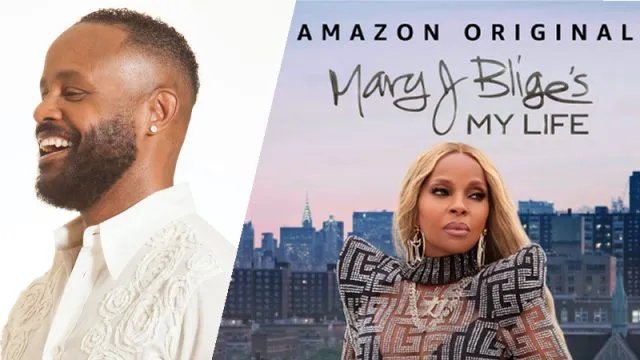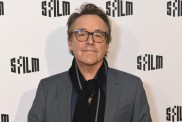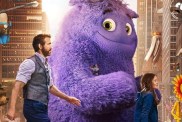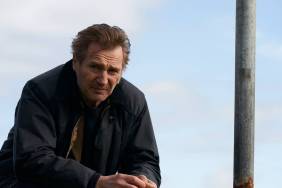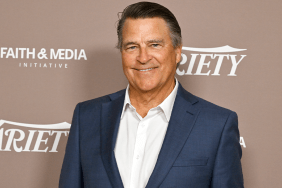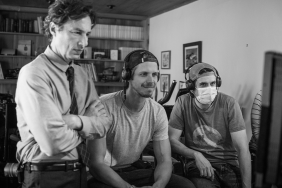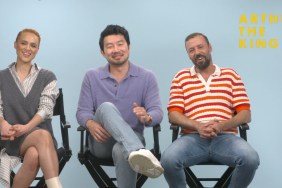The documentary Mary J. Blige’s My Life is now streaming on Amazon, which set up the perfect opportunity to speak with the film’s composer, Mervyn Warren. The 5x Grammy Award-winning artist, who was handpicked by the great Quincy Jones to work on Blige’s doc, discussed his musical process, his time scoring alongside Marc Shaiman, his amazing score for the 1997 superhero film Steel as well as his experience working with the legendary Whitney Houston.
Warren has worked on a number of classic productions, including Spike Lee’s Do the Right Thing, on which he provided lyrics and music for the song “Don’t Shoot Me,” Ron Howard’s The Paper, the 2009 Oscar winner The Blind Side, and the TV series, Six Feet Under, along with many others. As a composer, he scored films such as A Walk to Remember, the aforementioned Steel, and Joyful Noise.
Here’s the synopsis for Mary J. Blige’s My Life: “Grammy-winning recording artist and actress Mary J. Blige reveals the demons and blessings that inspired her 1994 LP ‘My Life,’ and celebrates the 25th anniversary of her most influential work by performing the album live for the first time.” Watch Mary J. Blige’s My Life here!
RELATED: Amazon Prime Video July 2021 Schedule: Movie & TV Titles Revealed
Jeff Ames: What drew you to the world of composing for film, TV, and documentaries?
Mervyn Warren: You know, I’ve always been sort of enamored with the idea of film composing even as a child, and I was really drawn to it. I’m fascinated by it and it was something that I wanted to do — I didn’t know how or when I would get to do it. And of course, my path to film composing took me through being a recording artist and arranging and producing for other artists. But I’ve always enjoyed that as a craft and I was thrilled and excited when I finally got the opportunity to do so and enjoyed it ever since.
How has your musical style evolved over the years as you’ve gotten into some of these bigger productions?
It’s sort of analogous — it’s not the same — but writing songs and writing score are sort of analogous to left brain, right brain. And that is a very imperfect analogy because they’re both creative. But my point is that there are different skills and different parts of the brain that are used, I think, when writing songs or writing a score; and so I’ve had to sort of bifurcate it, if you will, because I do both. And I enjoy doing both, but film score is a very different process and that’s something else I’ve had to learn. I wasn’t formally taught film scoring. I had to sort of learn that on my own. Sometimes, when I see the things that I did many, many years ago, I say, “You know, I would have approached that differently now.” I don’t know exactly how to put it into words, what I would do differently, but sometimes I hear things and say, I would definitely approach that differently now. So, there has been an evolution, I guess it’s growth, I guess it’s maturity, but it’s difficult, I think, to sort of quantify it and put it into words exactly what has changed.
But certainly, I will say this: film music has changed. And I think that’s because as budgets have gotten tighter, people can’t always afford to have an 80-piece orchestra. So, composers have learned to work with a lot of different tools and I think scores are evolving and we are all evolving to meet the demands of each project according to what the budgets afford.
Was there a mentor or someone who took you under their wing and helped you learn the process of film scoring?
Yes. I would have to say that was Marc Shaiman. I had produced an album called Handel’s Messiah: A Soulful Celebration, featuring different arrangements of pieces from “Handel’s Messiah,” and we won a Grammy for that and we performed at the Grammys that year. Two, maybe three or four days later, I got a call from Matt Walker at Disney saying, “We’re working on a movie. We saw you on TV. We’d love for you to participate if you’re interested.” And I said, “Are you kidding? Of course I’m interested!” And that was Sister Act 2: Back in the Habit.
So they flew me out — I was still living in Nashville — they flew me out. I started working on Sister Act 2, which was being helmed by Marc Shaiman, who had done the original Sister Act. In fact, it was Marc who had seen me on TV and had said, “Get that kid!” And so, they brought me out and I worked very closely with Marc. I did the arrangements for the kids on my own, but I worked with Marc and kind of looked over his shoulder and saw how he was working. Ultimately, I moved to LA within months of that. And I used to sort of look over Marc’s shoulder as he was working on all kinds of things that he was doing at the time.
So, I did learn a lot from him on Sister Act 2. Although, Marc was doing songs on that particular movie, the late Miles Goodman was writing the score and he was generous enough to allow me to co-compose some cues with him. So, I learned some techniques from him as well over the years. There were others, but I’d have to say more than anyone, I think Marc — because Marc’s door was open and I was constantly walking through it — I did learn quite a bit from him.
Now you’re selected by the great Quincy Jones and Mary J. Blige to work on this new documentary, Mary J. Blige’s My Life. What was your reaction to landing this gig?
I was very excited! I’ve had a long relationship with Quincy, and from time to time, I hear from him with different projects. So, it wasn’t unusual necessarily to get a call from his office, but it’s always exciting because you never know what he’s got up his sleeve and this time it was another movie. Mary and her team had reached out to Quincy — of course, she and Quincy had been friends for many years — and she says, “I need a score.” And he says, “I’ve got a guy.” They reached out to me and I knew, even before seeing the film, I just knew that it was going to be a powerful and moving account of her life. I knew right away that it was something to be excited about and something that I was going to end up being proud of.
I didn’t actually work with Mary directly. The film was directed by Vanessa Roth and had been shot and edited. That’s when they’re ready for a score. Vanessa is a wonderful director and this was in the middle of the pandemic, so we had all these meetings over Zoom talking about the tone of the film of what she wanted the score to be like. I got to work in my studio in solitude because of the pandemic. Because, of course, the film contains a lot of Mary’s songs. They help tell Mary’s life story and they use songs from her album entitled “My Life,” so there’s already in a way some underscore there — it’s not used as underscore, you see the performances or you hear music but there’s a lot of music.
When you have a film that already has a lot of songs, you want the score to contrast with those songs so that the listener isn’t hearing the same kind of thing over and over. It was important to Vanessa and to me to write music that complimented the songs, but that had its own distinctive flavor. I used strings and a lot of electric pianos because Mary’s songs use a lot of piano. I wanted the score to tie in with her songs, but again, make it different. So, I use a lot of electric pianos and strings, guitars, and a solo voice — the solo voice is there too. That actually was Vanessa’s idea. There are these great animated sequences in the film showing Mary often as a child and also some other points of her life as an adult, and that was a real opportunity for me to do something different, but Vanessa wanted to hear a voice to sort of represent, well, it could represent childhood, it could represent contemplation; sometimes it represents sadness, solitude. And so, that’s another element that you’ll hear throughout the score as well.
Are there moments in projects like this where you write a bunch of music and then discover a new idea late in the game that you then must incorporate into the stuff you’ve already completed?
Yes, that can happen. That can happen. I don’t think it happened on this one. Part of the process at the very beginning of any score is sort of defining what the palette is going to be, what the sound of the score is going to be. And I will admit that I did something at the very beginning. I did something really daring and sort of off-beat, and I thought, I just want to try this and see what Vanessa says — and she didn’t care for it. (Laughs)
Admittedly, it was — I don’t want to say it was out of left field, it wasn’t, but it was just sort of daring. And she said, “No, I really think I want to do something a little more understated.” So, I said, “Okay, fine.” I went back and did something more understated and then she goes, “Bingo! I love that.” And that’s what we did. Now, I will mention that, kind of along the lines of your question, there’s a new song that Mary wrote and performs over the end credits. That song begins with four very distinctive piano notes that repeat. As soon as I heard that, I said, “Oh my God, I want to incorporate that into the score!” I mentioned that to Vanessa and mentioned it to Amazon, and they liked the idea. Of course, we also had to clear that with Mary and the other writers of the song. On a few of the cues that I wrote, where I wanted to incorporate that, I had to do two versions because we weren’t sure that I was going to get permission to use those four notes. Ultimately, we did get permission, and so those are included. Those things sometimes take a little bit of time. There were multiple writers on the song and I had to get everyone to sign off. So, I did have some alternate versions.
I think what happens is you hear those four notes at strategic moments throughout the score and then I think there’s going to be a payoff with those four notes at the very end of the movie when those four notes become the intro to a song that Mary sings. I think, or I hope, that the fans will maybe subliminally have heard that as a little theme or mini-theme throughout the film, and then it pays off as a new song from their hero Mary at the end.
Switching gears here slightly, I have to ask about your score for the superhero film Steel with Shaquille O’Neal, which I saw opening day, by the way.
(Laughs) That is another score that I was hired to write because of Quincy Jones. Quincy was actually, if I’m not mistaken, a producer or an executive producer on that film — one or the other. He hired me to write the score. That was a big score! I think we had a 105-piece orchestra. It was a big score and a big opportunity, and I just wanted the score to have a heroic feel, but it also was a gritty film. The character Steel had some toys, but they weren’t high tech toys, they were lower tech toys (laughs) and I wanted the score to have sort of a gritty feel. I combined drums — not expensive drums, but sort of street drums, if you will, with orchestra. And I remember at the time wondering, “Has anybody ever done anything like this before?” I was very proud of the outcome. Unfortunately, it’s not a film that a lot of people saw. (Laughs) Thank you for seeing it.
It was a big learning experience for me and it was a lot of fun to have that many musicians in a room and to be able to write music for a huge group like that. In fact, one of my orchestrators was Steven Scott Smalley, who was one of the orchestrators from the Batman series. So, there was another sort of tie-in there. I was using his incredible skills to help me meet that challenge of such a huge orchestra.
You also worked alongside the amazing Whitney Houston. Is there a particular moment or experience working with her that you could share?
Sure! Working with Whitney, I mean, aside from working with her, I was a fan. I was a fan remain a fan and always just remember — I mean, even now I get goosebumps thinking about it —just that her voice was so remarkable, but what she did with it, I know it’s so cliche to say, “once in a lifetime,” but that’s really what she was.
When I got to work with her on The Preacher’s Wife, and then later on her Christmas album, I produced about half — I think — of her Christmas album, but it was just such a joy to me to have written these arrangements or in one case an original song, for her and to have created these arrangements and then to have that voice added to the palette that I created. Once she started singing, I would just sort of melt! (Laughs) Sometimes I would maintain my composure enough to say things to her and ask, “Hey, what have you tried this?”
Look at me implying that I was telling Whitney how to sing! As a producer, that’s your job. I mean, I wasn’t telling her how to sing, because she knew how to do that, but I was making some suggestions here or there. But inside I was melting and screaming going, “Oh my God, it’s Whitney Houston!” while I was also doing my job. I guess that’s the point I’m trying to make.
She was just wonderful. We laughed a lot. I have a picture that someone took of us in the studio and we were just bowled over, laughing at something … who knows what? She was just a wonderful spirit and she is greatly missed — not only her voice, but her as a person. She was a fantastic woman.
